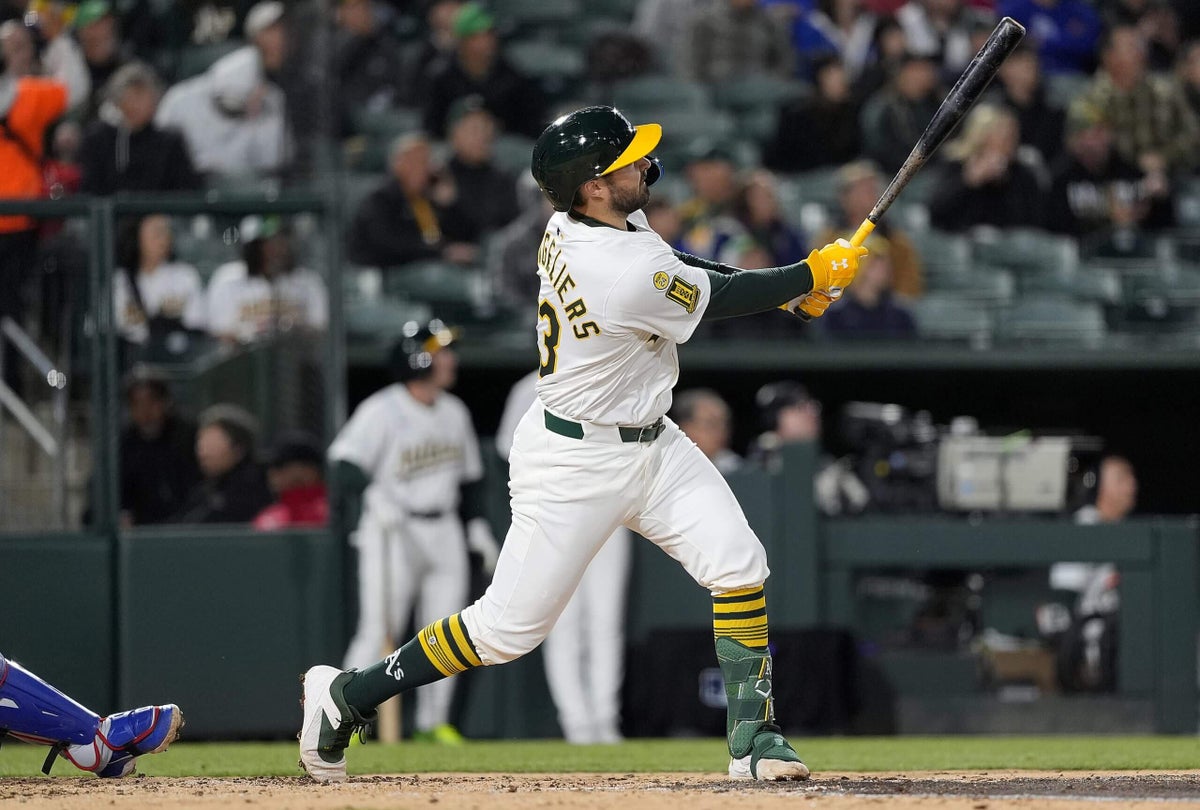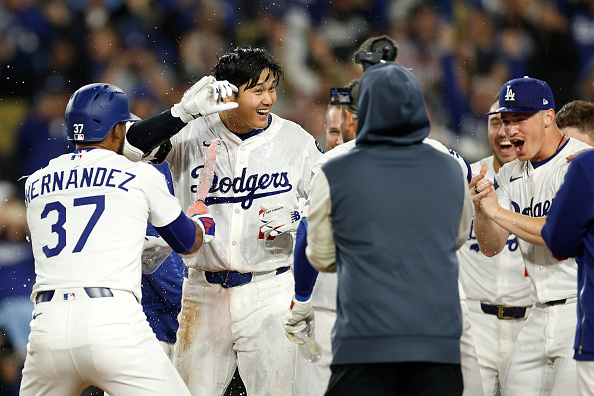
Heading into the latter half of April, birds chirp, flowers bloom, and signal tentatively begins to merge amid the statistical noise.
One statistic that becomes meaningful early — around 60 plate appearances — is strikeout rate, which doesn’t mean previous years can be ignored. However, we should factor in 2025 K rates into our analysis. Here are your biggest K% improvers thus far, along with their wOBAs (to get a better sense of their overall offensive production).
|
Player
|
2024 K%
|
2025 K%
|
24 K% – 25 K%
|
2024 wOBA
|
2025 wOBA
|
2025 xwOBA
|
|---|---|---|---|---|---|---|
|
29.3 |
12.5 |
16.8 |
0.287 |
0.431 |
0.439 |
|
|
27.2 |
10.9 |
16.3 |
0.315 |
0.375 |
0.387 |
|
|
21.3 |
8.7 |
12.6 |
0.296 |
0.333 |
0.366 |
|
|
33.6 |
21.4 |
12.2 |
0.36 |
0.359 |
0.37 |
|
|
19.6 |
7.5 |
12.1 |
0.29 |
0.336 |
0.358 |
|
|
27.8 |
15.9 |
11.9 |
0.296 |
0.308 |
0.377 |
|
|
24.7 |
13.7 |
11 |
0.34 |
0.498 |
0.496 |
|
|
28.8 |
18.6 |
10.2 |
0.324 |
0.251 |
0.322 |
|
|
31.7 |
21.6 |
10.1 |
0.357 |
0.342 |
0.269 |
|
|
29.7 |
19.7 |
10 |
0.356 |
0.223 |
0.295 |
This list includes players at all infield positions and three outfielders, so it’s possible that someone out there has this exact team. And if you do, you’re a genius, but hopefully, you also went heavy on pitching.
Jorge Polanco isn’t going to keep this up, but he has made adjustments, and those are obviously paying off so far. The biggest difference is he’s swinging more, especially on pitches inside. That’s led to his K rate and BB rate plummeting, and his .367 BABIP (almost 100 points higher than last year) does the rest. Expect him to come back to Earth. His barrel and hard hit rates are up, and he’s hitting a good dose of line drives. He’ll likely be a solid contributor moving forward, just not the star he’s been thus far.
Advertisement
Shea Langeliers, on the other hand, is making gains by being more selective, not less, and what he’s doing looks fairly sustainable. The power has always been there; it’s just usually accompanied by a hefty dose of strikeouts. So far, his swinging strike rate is down significantly to 8.4%, he’s chasing less, and he’s still getting to the power — he has already hit a ball harder than 114 MPH, which he had never done before. I’m in.
Ty France has been good, and by his expected stats, he’s been even better. How he’s making that happen, however, is suspect. His contact rate hasn’t changed, and he’s not getting any BABIP luck. France is feasting on low pitches, including ones below the zone. It doesn’t feel like it will ast, but he is posting the best barrel rate of his career, and it’s a reminder that France had a three-year run of being well above league average from 2020 to 2022. Put him in the Polanco category of guys who have made real improvements and will settle into something more average.
I don’t like how much Tyler O’Neill is chasing, but everything else suggests a player who is about to go off. He has built on last year’s re-breakout with slightly improved barrel and swinging strike rates. The K% will likely drift up a bit, but he managed to hit 31 homers in 473 plate appearances last year with a 33.6% strikeout rate. If his health holds up (always an “if”), I see that kind of power reappearing, as his unlucky 8.7% home-run-to-fly-ball rate improves. Buy low if you can.
Speaking of buy-lows who are chasing too much, based on surface stats, Adolis García looks like he’s continuing his slide from last year, when his barrel rate dropped four points, leading to a sluggish .224 BA and 25 HR. This year, the barrel rate is up above his 2023 peak, but that’s hiding behind his .209 BABIP and 6.7% HR/FB. Two-thirds of his batted balls have been flies, which helps explain both of those stats, and the chase rate is up, so I don’t anticipate a full 2023 repeat, but as we head into May, he should start looking more like the guy you wanted when you drafted him.
Advertisement
How about Ezequiel Tovar? It’s been a weird and pretty ugly year for him so far. He is making more contact when he swings and is swinging far less. He was among the worst chasers in the league last year, so an improvement there is welcome, but he’s also simply swinging far less, and his barrel rate has dropped down to 5.7%, which won’t do much, even in the light air of Denver. His x-stats indicate that he deserves a significantly better average and slugging percentage. He’ll improve, but I’m always wary of players who don’t have a good sense of the zone, and his attempts to mitigate that haven’t gone well so far.
It’s the same story for Mark Vientos: fewer swings, Ks, barrels, and an unplayable stat line. Pitchers have largely stopped throwing him off-speed pitches, but he hasn’t been hitting anything, so the shift can’t have mattered too much. He’s also getting less to work with on the inner part of the plate. The .188 BABIP can only go up, and he will start hitting homers at some point. I have faith the good version of him will ultimately appear, but Vientos might need an adjustment or two before that happens.
The polar bear at the other corner of the Mets’ infield is making up for it. Pete Alonso is as locked in as he’s been in his career. He won’t keep up the .365 batting average, but he is chasing less and smoking the ball when he swings.
It’s been all contact and no power for Jacob Young, but that can work with elite speed and command of the zone. He’s been maxing out on his particular skill set by chasing very little and making contact 95% of the time he swings. Weirdly, he’s only stolen one base, but that number ought to rise if he can keep any semblance of his start through the season. He swiped 33 bases last year.
Tyler Fitzgerald is your other burner here, and he is using his legs to run up BABIPs that look way too high. His .353 figure is actually a drop from the .380 BABIP he had last year. His swinging strike rate is up, and I don’t think he can hold a low-20s K rate, but he’s sneakily useful.
Now, let’s take a peek at the five biggest K% gainers among qualified hitters.
|
Player
|
2024 K%
|
2025 K%
|
24 K% – 25 K%
|
2024 wOBA
|
2025 wOBA
|
2025 xwOBA
|
|---|---|---|---|---|---|---|
|
26.7 |
41.8 |
-15.1 |
0.355 |
0.294 |
0.246 |
|
|
17.1 |
31.4 |
-14.3 |
0.315 |
0.281 |
0.269 |
|
|
32.1 |
46 |
-13.9 |
0.329 |
0.185 |
0.216 |
|
|
22.1 |
35.9 |
-13.8 |
0.381 |
0.262 |
0.277 |
|
|
15.6 |
29.3 |
-13.7 |
0.322 |
0.232 |
0.285 |
Riley Greene still has huge power, but he has been a one-dimensional slugger so far this year, with more swings at pitches out of the zone and more whiffs on pitches in it. As with Vientos, he’s too good for this to last, but a K rate over 40% is unplayable, and he’s not going to turn back into his regular self overnight.
Advertisement
Masyn Winn is emulating Tovar by swinging less with disastrous results. His 37.4% swing rate is very passive, and the 79% zone-contact rate is bewildering. He has some interesting tools, but he’s droppable in most formats.
So is Michael Toglia and his 46% strikeout rate. I was pretty excited about him going into the year, but this is painful. He’s always had high K rates, but, like Winn, his in-zone contact rate has cratered to 74%.
It’s been a rough start for Gunnar Henderson, but it is just a start. He missed almost all of spring training and is clearly still getting warmed up. No cause for alarm just yet.
As for Cody Bellinger, his contact rate is way down, but everything else looks normal enough. The .229 BABIP will come up, and at some point, he’ll discover the short right porch at Yankee Stadium. Something is clearly off with him, but I’d still put him as a modest buy-low.
Access The Athletic’s guide for abbreviations used in fantasy baseball.
(Top photo of Shea Langeliers: Thearon W. Henderson / Getty Images)


